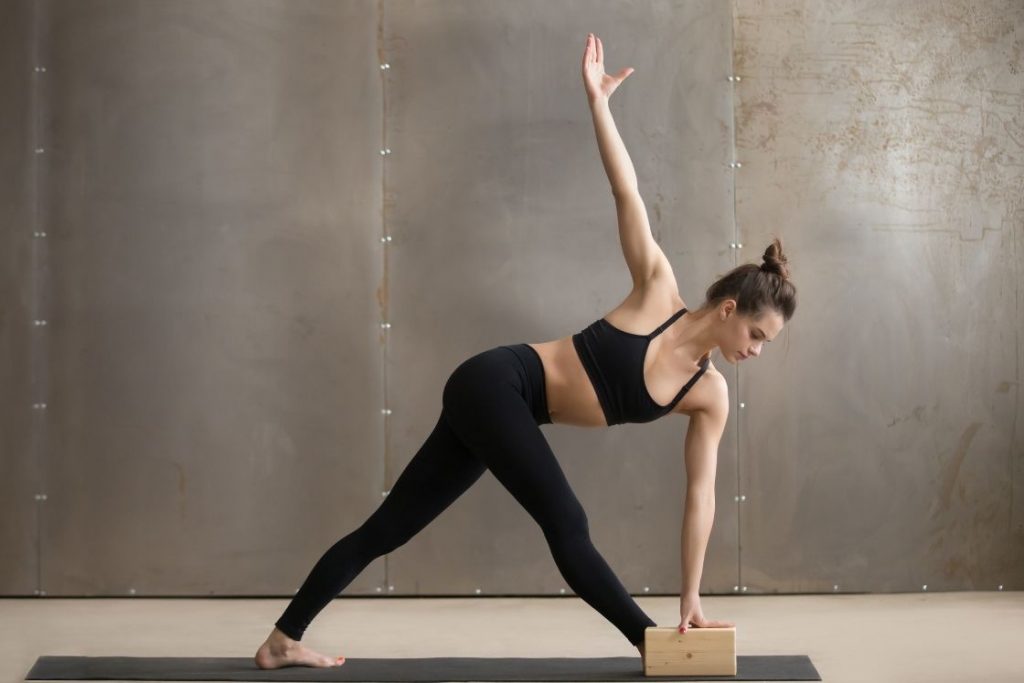
If you’re a beginner, it can sometimes be hard to perform some poses due to a lack of flexibility and mobility of some body parts. Or if you’re an experienced practitioner, you may want additional motion range or challenge yourself to go deeper into a pose.
Yoga props are a great way to achieve both goals. Props such as blocks, straps, ropes, give you the freedom to practice your yoga poses freely and also provide support.
Yoga blocks are also a prop that is most commonly used by yoga practitioners. It can provide you support, make poses more accessible and develop your strength. And just like any other prop, it is a tool to make your practice safer.
A typical yoga block has the dimension of 4″ x 6″ x 9″ however you can also find various other sizes based on your height (5” for tall people and 3” for short people), flexibility, and other preferences
Are yoga blocks and yoga bricks same?
It is quite easy to get confused between a yoga block and a brick as they serve the same purpose. However, the difference lies in their dimensions.
A yoga brick is smaller and resembles a typical brick in shape. They are a lot denser and are often used in poses where you are required to reach the floor such as triangle, side angle pose, half-moon pose, forward bends, etc. The brick can be used on all its sides without the fear of tipping.
A yoga block is flat on the top and is often used in seated poses. The flat-top provides perfect support for comfortable sitting for a long duration. Since it has a wider flat surface, using the sides is not recommended as they are much narrower. You can stack them to get the desired length for your seated poses.
You can use both of them simultaneously to provide a range of motions in your poses. They can be used by beginners and advanced practitioners alike.
Benefits of using Yoga Blocks
Using yoga blocks ensure safety. It acts as a support when you are unable to move certain body parts due to a lack of flexibility or mobility. You can modify the pose by using yoga blocks. It is especially beneficial in case of pregnancy yoga or recovery from an injury.
- Using yoga block as a height tool reduces the distance between the ground and your body in forward bend poses. This also helps in reducing injury.
- It helps in correcting your posture for the pose and holding the pose for a longer duration.
- It is a great tool that provides stability for beginners.
- You can engage your muscles by pressing onto the block to release tension and tightness.
- For experienced practitioners, a yoga block can act as a tool for deepening a pose and adding weight to enhance muscle strength.
- It increases your awareness regarding internal and external muscle movement.
A yoga block will also increase your confidence and remove the fear of practicing the more difficult poses. You will always have an option of using a yoga block as your support till the time you feel you are ready to perform without it.
Types of Yoga Blocks
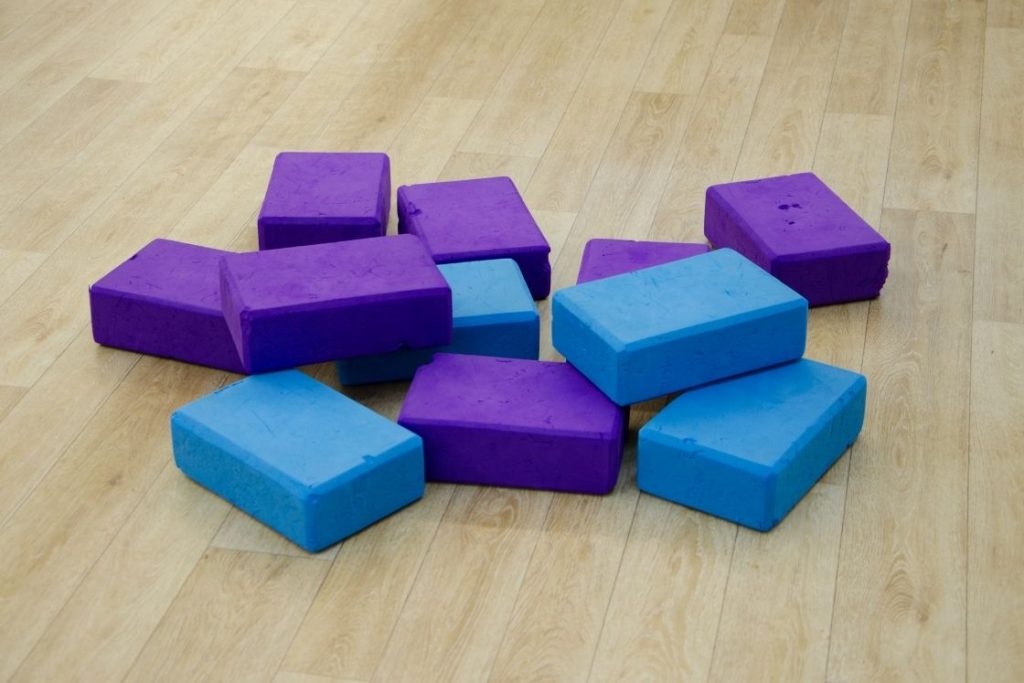
When searching for a yoga block you need to keep certain important aspects in mind:
- The size of the block
- The material it is made of
- The shape you want as per your need
- The block’s weight and density
- Their durability
We have listed some common types of yoga blocks available in the market.
Wood yoga blocks
A wooden block is solid and sturdy enough to hold your weight. Most original wood blocks are made from pine, bamboo, or birch. They are pleasant in looking and easy to clean. You can use such blocks for strength building or balancing yoga exercises.
Wooden blocks are pricey, heavy, and not easy to carry. Since they are hard, you may find it uncomfortable to use in many restorative yoga poses and backbends. The traction with the hand may easily decline if you sweat too much, therefore, it’s also not recommended for hot yoga. Due to their smooth surface, you may not find it easy to stack them.
Cork yoga blocks
Cork yoga blocks are eco-friendly and less heavy than wooden blocks. They are quite stable and durable. As their texture is a bit rough, it is easy to hold them even if your hands get sweaty and can be easily stacked on top of each other.
On the flip side, this rough texture is also porous. This means that cork yoga blocks can easily absorb the sweat and cause a bad odor to emit after a certain time. It is not easy to clean and the corners can start crumbling if the cork is not of good quality. Some people may still find the cork yoga blocks to be too firm.
Foam yoga blocks
Foam is one of the cheapest and lightweight materials for yoga blocks available in the market. They are soft, gentle and squishy to support the body in any pose. You can easily carry them and are easy to clean.
But if the foam is not of good quality, it may break down sooner than you expect. They can easily dent due to their softness and have a high chance of collapsing if used rigorously.
7 yoga poses you can modify using yoga blocks
Yoga blocks can be easily used with many poses as support or bring the floor closer to you. We have listed a few poses that you can perform with yoga blocks easily.
1. Child’s Pose (Balasana)
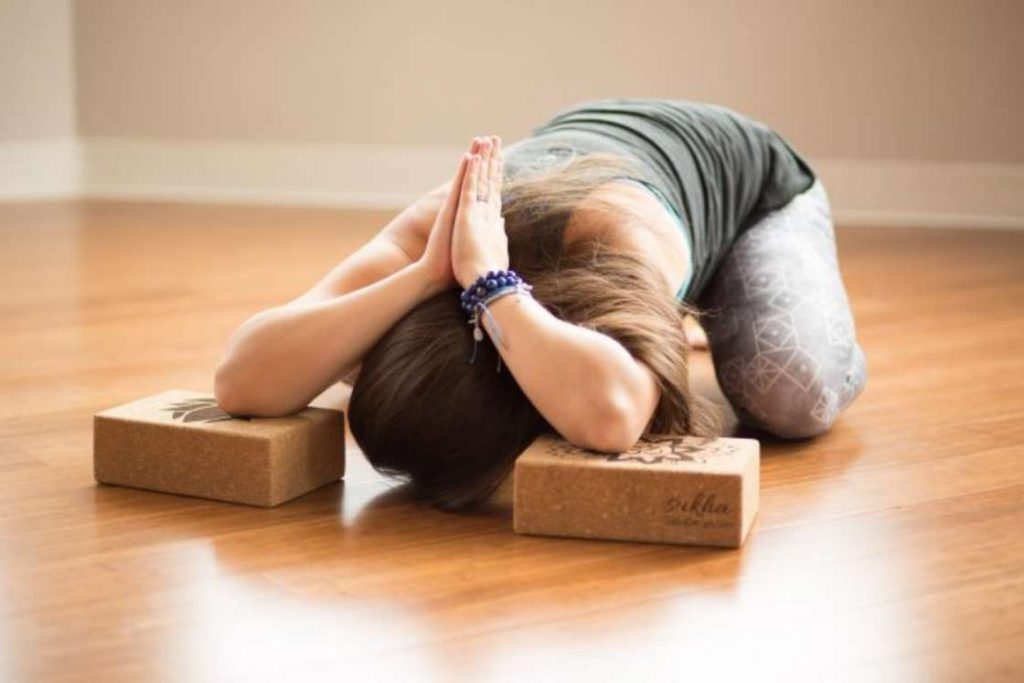
The child’s pose is one of the relaxing and restorative poses which calms your mind. However, some students may find difficulty in bending forward due to the stiffness of the hips. It is also sometimes not possible to bring the head completely closer to the ground.
In such cases, you can use a yoga block for support and increasing mobility.
For this pose, sit in a Vajrasana with a straight spine and your sitting bone should be placed on your heels. Your toes should be tucked in so that the big toes are touching each other. Engage your hips and start bending forward till the time your abdomen touches your thighs. You can spread your arms in front of you or keep them by your side.
How a yoga block helps in child’s pose
Using a yoga block in child’s pose assist in supporting the weight of your head. To keep the spine straight, place a block to rest your forehead in the final pose.
In child’s pose, a block can be placed under the tailbone to support the lower back. Additionally, you can place blocks to rest your elbows or forearms for a deeper arm, shoulder and chest stretch.
2. Bridge Pose (Setu Bandhasana)
The bridge pose is a great backbend to stimulate your backside. It strengthens the back muscles and is a wonderful chest opener pose. Many students are unable to engage their hips and thighs to lift their hips properly. Due to this, the knees get misaligned which may cause a strain on the back.
A yoga block can help in keeping the alignment and provide support to your hips in such backbend poses.
To practice bridge pose lay on your back and bend your knees so they are perpendicular to the floor. Your knees should be directly stacked on top of the ankles. Place your arms beside you, palms down. With your palms and feet firmly on the ground, engage your core and hips muscles and lift your hips from the ground. Your lower body up to your chest should be lifted off the ground.
How a yoga block helps in bridge pose
In bridge pose, to keep the correct alignment, place a yoga block at its narrowest width between the thighs. Squeeze the block to lift your hips and keep your knees in place.
Another commonly used method is to place a block under the sacrum for support in bridge pose. The height of the block can vary as per your requirements and comfort. You also have the option of using more than one block for raising your hips higher.
3. Triangle Pose (Utthita Trikonasana)
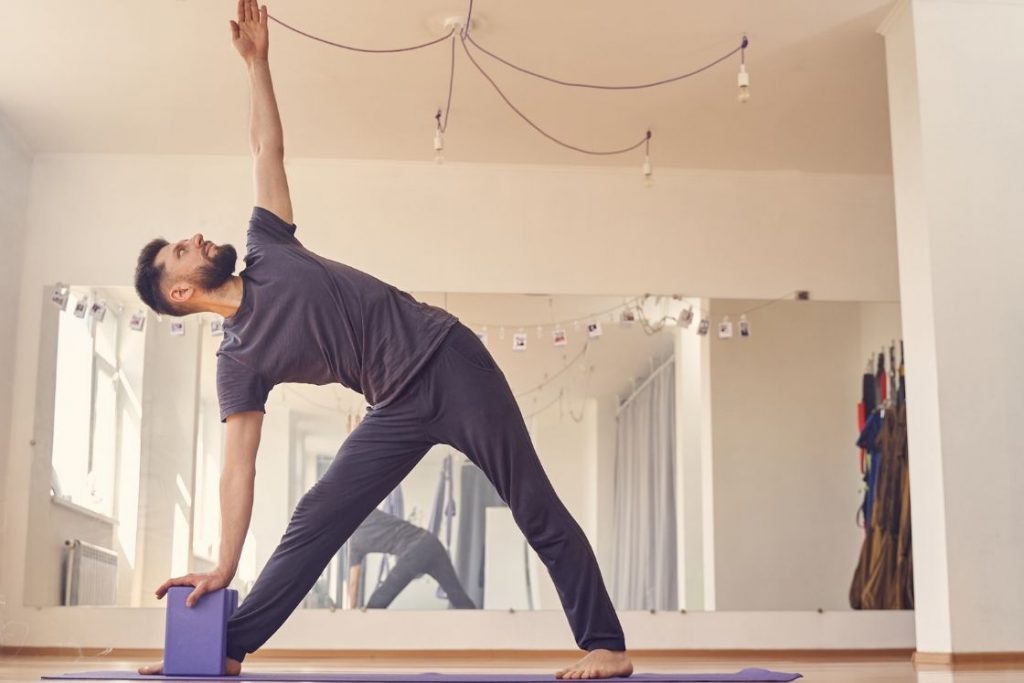
Triangle pose helps in opening the chest and hips along with strengthening the back, spine, and shoulders. Initially, it may seem easy to perform, however, if someone has stiffness in their hips, shoulder, and back, this pose can prove to be difficult.
A yoga block in triangle pose can be a great prop to bridge the gap between your hands and the ground.
To practice this pose, stand in Tadasana and spread your legs 3 feet apart. You can adjust the width as per your balance and comfort. Turn your right foot toward the shorter end of the mat. Your left foot should be turned diagonally so that both heels are in line.
Spread your arms sideways and slowly start bending forward. Make sure your feet are firmly placed on the ground and your hips are facing forward. Keep bending till your arms are in a straight line with shoulders stacked on top of each other. Turn your head to gaze over your left shoulder.
How a yoga block helps in triangle pose
Use a yoga block to keep your hands on it as a support. This is the most beneficial for people who are unable to bring their hands completely to the ground. The height of the block can be adjusted as per your need.
You can also hold the blocks in your hands. Squeeze them while taking your biceps near your ears and bend sideways for a deeper stretch to the shoulders and arms.
4. Half Moon Pose (Ardha Chandrasana)
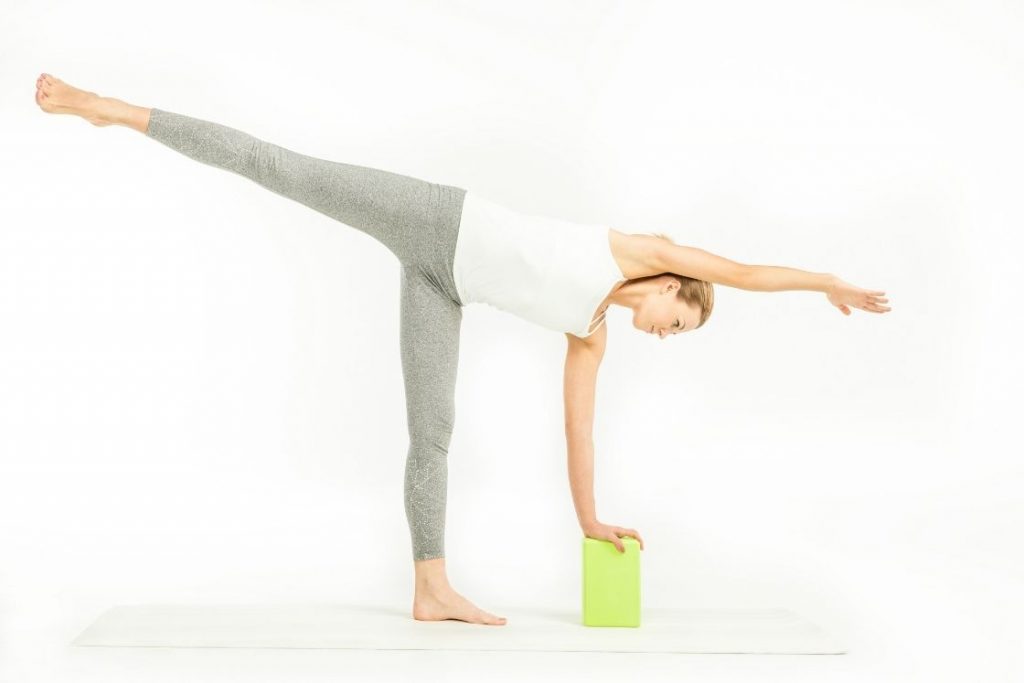
The half moon pose is a balancing pose that utilized your core muscles. It also works to strengthen the thighs, buttocks, ankles, and abdomen. This pose also helps in lengthening the spine and stretching the groin, hamstrings, and calves.
Being a balancing pose, many practitioners shy away from half moon pose as they deem it difficult. Not saying it isn’t a difficult pose, a yoga block can easily solve the problem by providing support.
This pose can be easily transitioned from the triangle pose. When you have reached the final stage of the pose, put some weight on your front leg, in this case, the right leg, and bring the back leg upwards. Keep your right leg straight, without locking your knees, and bring your left leg up so that it is parallel to the ground.
How a yoga block helps in half moon pose
Just like you placed the block to support the lower hand in the triangle pose, the same way a block can be used half moon pose. You can start placing the block on the highest length and gradually change the setting when you feel you have gained enough strength. Gradually flip the side of the block to decrease the height and reach the ground with reduced height.
5. Camel Pose (Ustrasana)
The camel pose is one of the intense backbend poses that releases tension and stress from the back, spine, and hips. It is also a great hip, chest, and heart opener. If you’re a person with a desk job that involves you being seated for long hours, this is one of the best poses to enhance your spine mobility.
However, as intense and beneficial as this pose is, students often strain or injure their backs when doing the back-bend. They do not use their thighs to protect the lower back and tend to bend from the lower back instead of the upper back.
A yoga block in camel pose can be a great way to engage your back muscles and keep your posture aligned, not risking further injury.
For this pose, come to a kneeling position with the hips aligned with your ankles and straight back. Place your hands in your lower back for support and push your hips forward. Keep your feet and shins firmly on the ground while tilting back through the upper spine.
Keep your elbows together, your chest pushed forward to expand your rib cage, and your shoulders relaxed. Place your hand on your ankles or on the ground for a deeper bend.
How a yoga block helps in camel pose
Place two yoga blocks on the outside of your feet. Place your hands on them for support and hold the pose longer. It will also help you in breathing effortlessly. Start with the highest setting and gradually change the sides till the time you find the confidence to touch your feet.
To support your back, you can also sit on a yoga block. Use the flattest surface for more comfort.
Another way to use blocks is by keeping them between your thighs to engage your thigh muscles.
To deepen the pose, place two blocks under your knees, on their lowest height.
6. Reclined Bound Angle Pose (Supta Baddha Konasana)
This is a restorative pose that is also a hip and chest opener. It helps in stretching your groins, knees, and inner thighs. The abdominal organs also get stimulated by this pose.
The main issue with this pose is if you have tight hips and groin, you sacrifice the alignment by straining your spine, shoulders, neck, and back to keep your knees lifted.
This pose can be performed by laying down on your back on the yoga mat. Bend your knees and pull the feet towards your groin, as close as you can. Join the soles of your feet as if you would join your hands in Anjali Mudra. Relax in this pose, with a straight back and neck. Lay your arms beside you with palms up or place them on top of your abdomen.
How a yoga block helps in recline bound angle pose
To get the correct alignment, place two yoga blocks under your knees for support. The height setting can vary based on the tightness of your hips and groin.
For advanced practitioners, place one block under your pelvis and another between the shoulder blades. It will deepen the stretch and further open your hips and chest. You need to be cognizant of the height as it can be an intense pose to practice.
7. Easy Pose (Sukhasana)
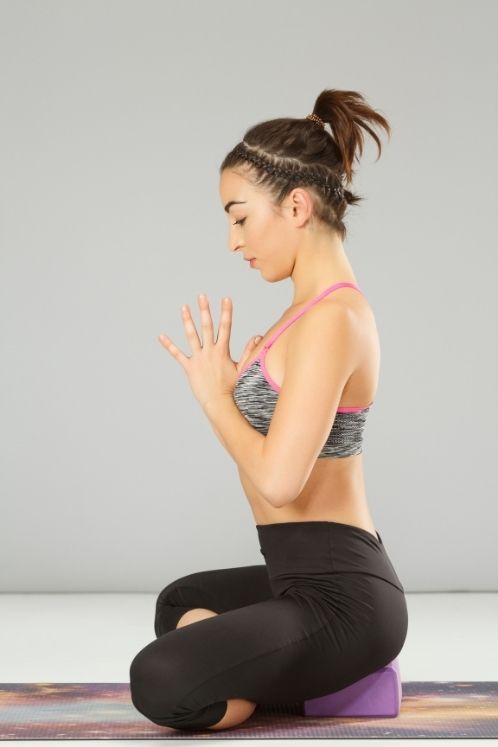
As the name suggests, it is one of the easiest poses to practice. It is often used as a starting point for most seated yoga poses, for meditation, and also during a transition. It is one of the perfect poses to lengthen your spine, improve body posture and open your chest and hips.
However, something that is easy can also be difficult to perform. Most of us do not sit with our spines straight, which leads to a distorted posture in easy pose. The curve of the spine not only compresses your spine but also your abdominal muscle.
Start by sitting on the yoga mat with your legs stretched out. Bend your right knee and bring your right foot towards your groin, as close as you can, by externally rotating your right thigh. Do the same with the left leg.
Here you have the option of keeping your left foot in front of the right foot or you can place the left calf on top of the right calf. Do not force your knees to touch the ground. Rest your hands in whichever way you want.
How a yoga block helps in easy pose
The yoga block can be used as sitting support to keep your spine straight. It is better to use the lowest height and the flattest surface for more comfort.
You can also use additional blocks to support your knees.
Conclusion
Do not think that if you are using a yoga block or any other prop to practice your asanas, you are not a true yogi. There must be some relevance if an entire stream of yoga is totally based on using props. Their purpose is to give you the confidence to practice a yoga asana with ease and proper awareness.
Once you start using yoga blocks, you will find that you can play with the different heights to deepen or lessen the stretch. You will become aware of the muscles being stimulated when performing certain poses. It will become easier for you to practice difficult poses and also challenge yourself with modifications and variations.




